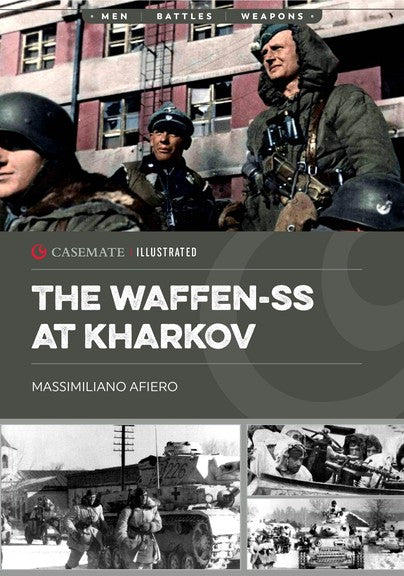The Waffen-SS At Kharkov
Usually shipped within 24 hours
UK deliveries from £5.95
Delivery & Returns
Delivery & Returns
We use the Royal Mail, DHL Express or UPS for our customers. For UK addresses, deliveries under 10kg are a standard £4.95 via Royal Mail Tracked 48 Service. For orders over 10kg and overseas customers, postage is calculated for you at checkout once you have entered your postal address. This price, does not include any potential custom charges that may apply, depending on the product or destination, as every country has very different import duties / taxes. Online exclusive products (such as trainers) will be delivered to you directly from the printer, separate from other items in your order, but your postage fee covers ALL items in your order.
If you are unhappy with your purchase, please email shop@tankmuseum.org within fourteen (14) working days of receiving your goods, and return it to us at the address below, in its original condition, unopened (with any seals and shrink-wrap intact) and we will issue you a full refund or replace it. Goods must be returned at your own cost. If the item is faulty, you do not need to return it, we will send you a replacement free of charge.
Description
Description
By Massimiliano Afiero
Paperback
At the beginning of 1943, the German armed forces were in crisis on the southern front in Russia. The Soviets had launched a series of offensives from November 1942 that pushed the Germans back hundreds of kilometers. The Germans had no more significant reserves available, and enormous breaches had opened between defensive lines. In early January 1943, the Soviets attacked again, with the aim of reconquering the industrial city of Kharkov and destroying the remaining German and Axis troops in southern Ukraine, including the 4. Panzerarmee, 1. Panzerarmee, Armeeabteilung Hollidt and Armeeabteilung Fretter‐Pico.
After the encirclement of 6. Armee at Stalingrad and the destruction of the Axis forces there, the loss of these four armies would certainly have led to German defeat on the Eastern Front. Believing victory was near, Stalin and his generals decided to launch their new offensives even before the garrison of Stalingrad surrendered. The main effort fell on Army Group Don, newly formed and with little forces available. Facing a massive offensive, Commander Erich von Manstein was ordered to hold the city at any cost, risking the destruction of two divisions of the Waffen‐SS and the “Grossdeutschland” army division. SS Panzer Corps commander Paul Hausser disobeyed Hitler’s order and ordered the retreat from Kharkov, saving the two SS divisions. This meant that Manstein had at his disposal forces needed to launch his counteroffensive.
The subsequent battles for Kharkov saw the three divisions of the Waffen‐SS—Leibstandarte Adolf Hitler, Das Reich and Totenkopf— fighting together for the first time. In the first phase of the offensive, the SS Das Reich and Totenkopf marched 100 kilometers south of Kharkov, blocking the Soviet army from capturing the bridges over the Dnieper River, while the Leibstandarte successfully defended the corps supply base in Krasnograd. After protecting the bridges over the Dnepr, the Das Reich and Totenkopf units headed north and regained control of the vital railway network south of Kharkov. The Soviet 3rd Tank Army was forced to abandon its attack against Krasnograd to regroup south of Kharkov and protect the city from Hausser’s divisions. At that point the Leibstandarte joined the other divisions of the corps SS to eliminate Soviet forces and recapture Kharkov. With its reconquest, Southern Ukraine returned firmly under German control.
This is a fully illustrated account of the decisive victory attained by the SS Panzer Corps divisions at a time of serious crisis for the Axis forces.
![The Waffen-SS At Kharkov Book [variant_option4]](http://tankmuseumshop.org/cdn/shop/files/52245.jpg?v=1738151054&width=1214)

![The Waffen-SS At Kharkov Book [variant_option4]](http://tankmuseumshop.org/cdn/shop/files/52245.jpg?v=1738151054&width=88)
![Tank Museum Playing Cards Game [variant_option4]](http://tankmuseumshop.org/cdn/shop/files/ProductShoot_10_10_2025035.jpg?v=1760358498&width=176)
![Tank Museum Wrapping Paper - Two sheet pack Wrapping Paper [variant_option4]](http://tankmuseumshop.org/cdn/shop/products/Wrapp_Paper_All.jpg?v=1748337915&width=176)
![The Waffen-SS At Kharkov Book [variant_option4]](http://tankmuseumshop.org/cdn/shop/files/52245.jpg?v=1738151054&width=640)



